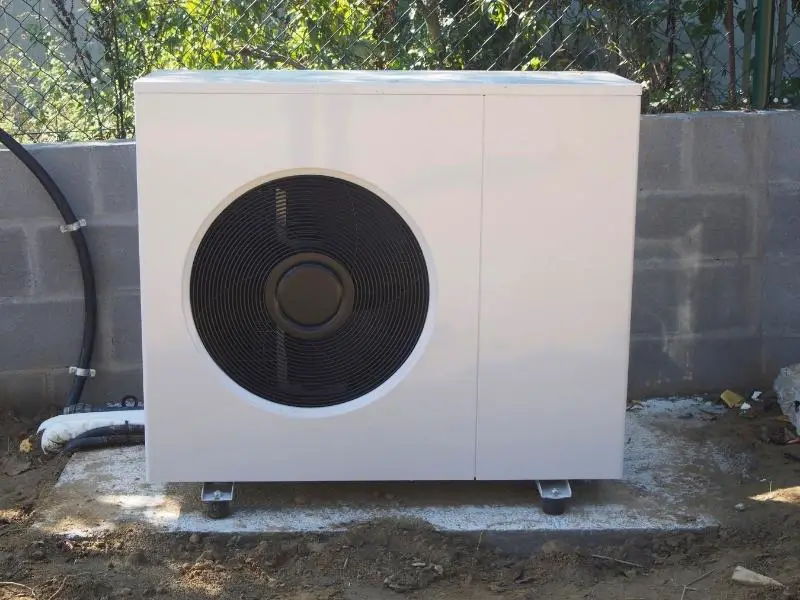Knowing the best location to install your outdoor heat pump will allow it to work more efficiently, extend the life of the equipment, and cost less money to operate. Location is everything. So just how far away can your heat pump be from the house?
An outdoor heat pump can be installed up to 100 feet away from the house.
When deciding on the best place to install your outdoor heat pump, there are several factors to consider, including:
- Ventilation
- Maintenance accessibility
- Environment
- Weather
This is how to select the best outdoor location for your heat pump by following a few simple guidelines.

Where Is the Best Place to Install an Outdoor Heat Pump?
If your outdoor heat pump can be placed up to 100 feet away from your house, that should provide several options for the location of the unit.
Keep the heat pump out of direct sunlight. If the unit becomes overheated, it will lose efficiency in its ability to heat your home. Try to find a location that will provide some shade during daylight hours.
It is very important to install your heat pump where it can get proper ventilation. A heat pump can only heat (or cool) your home efficiently with an abundance of fresh air. Any airflow obstruction will diminish the output of the unit and cause it to use more energy.
This will in turn increase the cost of operation as well as shorten the lifespan of the unit.
Be sure to install your heat pump in an open space. Avoid installing an outdoor heat pump in an enclosed area such as a garage where the unit has restricted airflow.
Is Your Heat Pump Easily Accessible?
Once you have determined where your heat pump will have the proper ventilation, you want to be sure the unit has maintenance accessibility.
You do not want to install your unit near abundant plant life or close to fences or walls where you may not be able to get to it easily. Be sure that there are a couple of feet of space around all sides.
A service technician should be able to move safely around the heat pump to inspect and maintain it properly.
- The heat pump should also be a minimum of 4 to 8 inches off the ground to ensure proper drainage for the unit. This will also make it easier to keep snow and leaves clear from under the heat pump that may potentially damage the unit’s components.
What Is the Environment Around the Heat Pump?
If you have a lot of vegetation surrounding your home, you do not want plants growing too close to your heat pump. Plants can obstruct the airflow of your unit, causing damage or malfunction. Keep plants at least 18 inches away from all sides of the heat pump and remove any weeds that grow close to the unit.
Avoid installing the unit near dusty areas like roads and driveways, where debris can blow into the unit and block airflow. The same can be said when mowing the lawn; do not blow grass clippings towards the heat pump.
Installing a heat pump in a coastal environment exposed to salt in the sea air may cause corrosion and shorten the lifespan of the unit. With proper placement and regular maintenance, the expected lifespan of a heat pump can be up to 15 years.
Will Weather Affect the Performance of a Heat Pump?
Outdoor heat pumps are designed to face harsh weather conditions. However, when choosing a location for your heat pump, you still want to help protect the unit from drifting snow, ice, falling branches, and leaves.
If the heat pump is located beneath an eave, make sure rain is not dripping directly into the unit.
The placement of the heat pump should not be where airflow is being blocked by a fence or wall. Do not cover your heat pump during the winter. Without proper ventilation, your pump can overheat and break down. Be sure that there is sufficient clearance above the unit to ensure adequate airflow.
It is possible to build a slanted plywood roof over the unit to protect it from the rain and snow. A tarp suspended a few feet above the heat pump would serve the same purpose without blocking the airflow.
If residing in a colder climate, elevate the unit several feet from the ground to protect it from snow build-up.
Will a Heat Pump Work in Extremely Cold Temperatures?
A heat pump is designed to work in extremely cold temperatures. However, the colder it gets, the harder the heat pump has to work, using more energy while producing less heat. Heat pumps are graded by the output generated at various temperatures.
It is not unusual for the heat pump to be covered in a layer of frost or ice during extremely cold temperatures.
When a heat pump is covered in frost or ice, the unit activates a defrost mode to keep the unit from freezing. Clear the unit from any significant snowfall for the heat pump to operate at maximum output. If the unit completely freezes over, use warm water to melt the ice covering the condenser.
If the heat pump loses its efficiency or shuts down completely, call an HVAC professional for inspection and repair.
Is a Heat Pump Better Away from the House?
Keep in mind that a heat pump compressor and fans will create noise, so do not position the unit close to your windows or your neighbor’s house. Install the heat pump in an open space away from locations where it could be a disturbance.
Cut down vibrations by installing the heat pump on a solid, concrete surface. Regular maintenance will also eliminate noise created by worn parts.
If putting up a barrier to reduce noise, be sure to leave enough room so that the heat pump remains accessible and has proper ventilation and airflow at all times.




